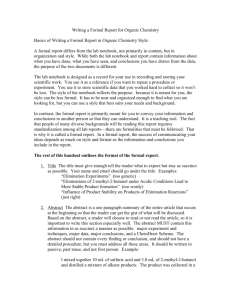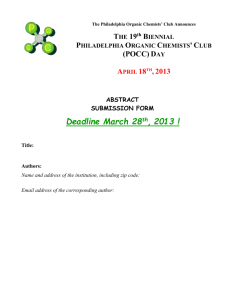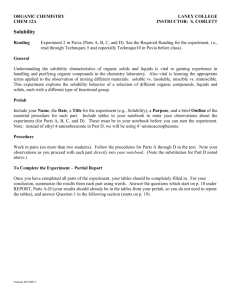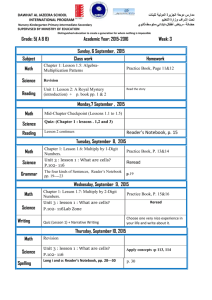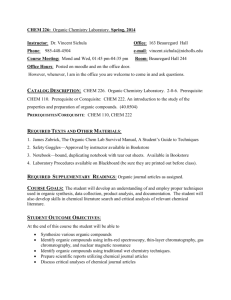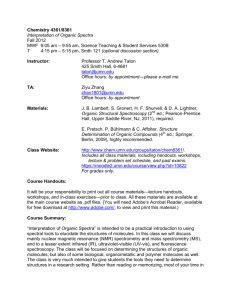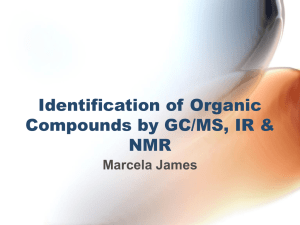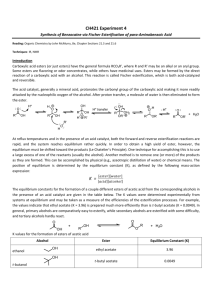Writing a Formal Report - Chemistry Courses: About
advertisement
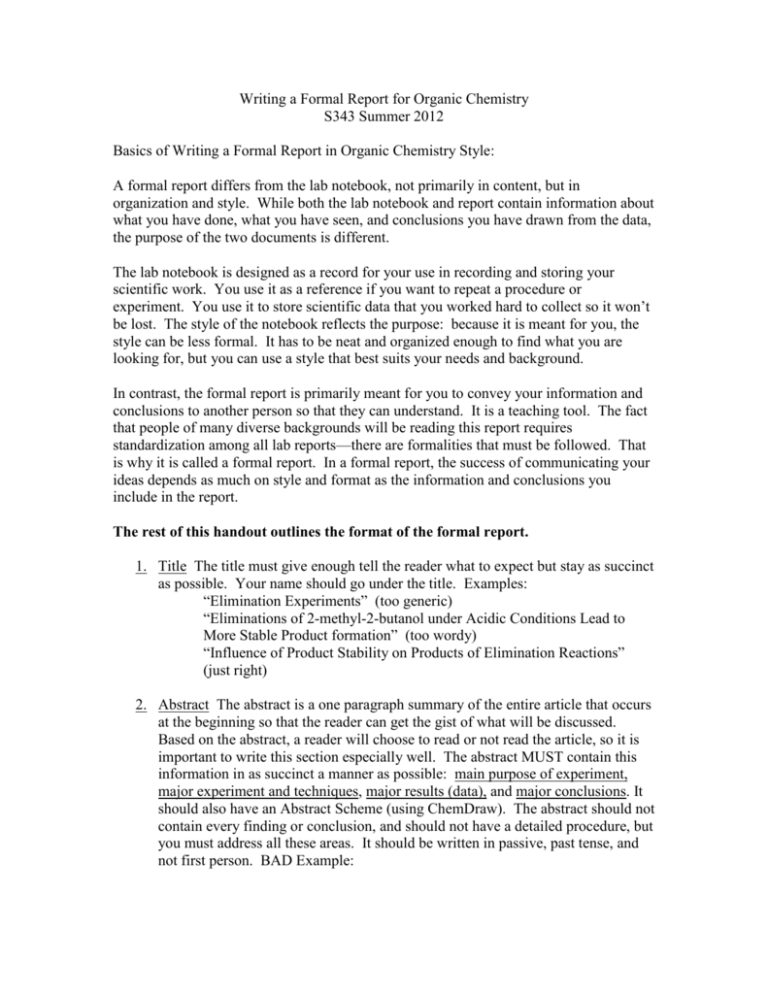
Writing a Formal Report for Organic Chemistry S343 Summer 2012 Basics of Writing a Formal Report in Organic Chemistry Style: A formal report differs from the lab notebook, not primarily in content, but in organization and style. While both the lab notebook and report contain information about what you have done, what you have seen, and conclusions you have drawn from the data, the purpose of the two documents is different. The lab notebook is designed as a record for your use in recording and storing your scientific work. You use it as a reference if you want to repeat a procedure or experiment. You use it to store scientific data that you worked hard to collect so it won’t be lost. The style of the notebook reflects the purpose: because it is meant for you, the style can be less formal. It has to be neat and organized enough to find what you are looking for, but you can use a style that best suits your needs and background. In contrast, the formal report is primarily meant for you to convey your information and conclusions to another person so that they can understand. It is a teaching tool. The fact that people of many diverse backgrounds will be reading this report requires standardization among all lab reports—there are formalities that must be followed. That is why it is called a formal report. In a formal report, the success of communicating your ideas depends as much on style and format as the information and conclusions you include in the report. The rest of this handout outlines the format of the formal report. 1. Title The title must give enough tell the reader what to expect but stay as succinct as possible. Your name should go under the title. Examples: “Elimination Experiments” (too generic) “Eliminations of 2-methyl-2-butanol under Acidic Conditions Lead to More Stable Product formation” (too wordy) “Influence of Product Stability on Products of Elimination Reactions” (just right) 2. Abstract The abstract is a one paragraph summary of the entire article that occurs at the beginning so that the reader can get the gist of what will be discussed. Based on the abstract, a reader will choose to read or not read the article, so it is important to write this section especially well. The abstract MUST contain this information in as succinct a manner as possible: main purpose of experiment, major experiment and techniques, major results (data), and major conclusions. It should also have an Abstract Scheme (using ChemDraw). The abstract should not contain every finding or conclusion, and should not have a detailed procedure, but you must address all these areas. It should be written in passive, past tense, and not first person. BAD Example: I mixed together 25 mL of hydrochloric acid and 10 mL of 2-methyl-2butanol in a separatory funnel. After two layers formed, I disposed of the bottom aqueous layer in the waste jar. I washed the organic layer with 20 mL of brine, then 20 mL of sodium bicardonate, then 10 mL of water then 10 mL of brine. I dried the product with calcium chloride abd distilled it. There was quite a bit of product collected. Problems: First person was used Too much experimental detail No reference to results or how they were obtained No scheme No major conclusions Good points: Past tense, passive Here is a better example of an abstract: 2-Chloro-2-methylbutane was synthesized from 2-methyl-2-butanol by treatment with concentrated hydrochloric acid. Distillation of the product gave a 68% yield with a boiling point of 84-86 oC, which matches the literature value for the expected product. 3. Introduction The introduction is included in the formal report for a few reasons. First, it gives the reader background into the scientific issues being discussed. What are some of the key terms and definitions used? How have other scientists approached the problem in the past and what have they concluded? Second, it gives the reader a perspective of why the research and findings are important to the scientific community. The introduction therefore is often highly cited with previous works. FOR THIS COURSE, you will often be given citations, but you will begin to learn how to find your own. 4. Results and Discussion This is the meat of the paper. In most organic chemistry papers, the results and discussion are not separated, but woven together into a seamless discussion that makes sense to the reader. The basic pattern is to introduce your point, THEN present data in a table or ChemDraw Scheme, THEN refer to that data to draw conclusions in your discussion. The best way to go about this is to come up with questions that you want to answer, then think about what figures or tables would convey the data in the most straightforward way. (You can attach copies of IR, NMR, or GC data to the end of the report with a figure number and caption.) After doing this groundwork, you can write the results and discussion section. For the formal reports, you should answer all questions given in the original lab handout. Other questions that you will generally answer, even if not explicitly asked include: Did I synthesize my target compound? What yield of the target did I get overall? How pure is the final product? Most importantly, WHAT DATA SUPPORT MY CONCLUSIONS? Common Figures/tables (may or may not be necessary, but often helpful) Main reaction scheme Tables of any IR/NMR/GC/etc data (turn in copies of actual spectra attached to the back of the report) 5. Conclusions: This is a summary of the paper, approximately one paragraph, but some people might write more. It is very similar to the abstract, but you might include future directions for the research. 6. Experimental Section: This is the place organic chemists give a detailed procedure of each reaction or experiment performed. First, you will write a paragraph outlining the general materials and equipment. For example, you might write, “All materials were obtained from the instructor and used without further purification. All IR spectra were obtained on a Hewlett-Packard Series 1600 IR spectrometer…” The next paragraph will outline the next experiment with a heading in bold. If it is a synthetic experiment, the heading will be the name of the compound made. If you used another paper as a reference for your procedure, cite the paper here. Following the name, a detailed procedure is given. It is written in past, passive. It includes actual gram or volume amounts used as well as molar amounts for reagents. The procedure should be detailed enough that someone else could successfully repeat the experiment exactly as you did. After the procedure, the amount of product obtained, product observations, and % yield are given. This is followed by a summary of all the characteristic data (m.p., TLC Rf and solvent, IR data and sample technique, 13C and 1H NMR data, and any other characterization data. If there are two experiments, the next one should start with a new heading. Here is an example of an experimental writeup for one compound reported in J. Org. Chem. 2011, 76, 9900-9918: (3R,4R,E)-7-((E)-3-Iodoallylamino)-2,4-dimethyl-7-oxohept-5-en-3-yl Acetate (30c). To a cooled (0 °C), stirred solution of vinylstannane 29c (543 mg, 1 mmol, 1 equiv) in CH2Cl2 (33 mL) was added iodine (381 mg, 1.5 mmol, 1.5 equiv). After being stirred for 20 min at 0 °C, the reaction was quenched with saturated Na2S2O3 solution until the reaction mixture turned colorless. The organic layer was separated, and the water layer was extracted with CH2Cl2 (2 × 20 mL). The combined organic layer was dried over MgSO4, filtered, and concentrated under reduced pressure. The residue was purified by column chromatography on silica gel (15% EtOAc/hexane) to afford vinyl iodide 30c (367 mg, 97%) as a slightly yellow thick oil: [α]20 D +8.9 (c = 3.6, CH2Cl2); 1H NMR (400 MHz, CDCl3) 6.65 (dd, J = 15.0, 8.0 Hz, 1H), 6.49 (dt, J = 14.5, 6.0 Hz, 1H), 6.24 (dt, J = 14.5, 1.5 Hz, 1H), 6.19 (br, 1H), 5.80 (dd, J = 15.5, 1.0 Hz, 1H), 4.70 (dd, J = 7.5, 5.0 Hz, 1H), 3.82 (m, 2 H), 2.56 (m, 1 H), 2.01 (s, 3H), 1.81 (m, 1 H), 0.98 (d, J = 7.0 Hz, 3H), 0.82 (d, J = 6.5 Hz, 3H), 0.81 (d, J = 7.0 Hz, 3H); 13C NMR (75 MHz, CDCl3) 170.9, 165.5, 145.8, 141.4, 123.3, 79.7, 78.4, 43.5, 38.3, 29.7, 20.8, 19.6, 16.4, 15.1 ppm; IR (thin film) νmax 3280, 2967, 1739, 1669, 1632, 1240, 1020 cm−1; HRMS (CI/NH3) m/z calcd for C14H23INO3 [M + H]+ 380.0723, found 380.0718. 7. Acknowledgements: You MUST acknowledge anyone who proofread your paper. If you worked as a team to obtain data, you must acknowledge your team members. 8. References: Normally, the Journal of Organic Chemistry has references as a set of footnotes, but it is fine if you have them as endnotes. You should use an appropriate format, though. The format for primary literature and an example are given below: (#) Name, initials.; Name, initials. Journal Abbrev. Year, volume #, pages-pages. (1) Chemist, F.A.; Student, J.D. J. Org. Chem. 2011, 73, 2345-2350. In this course, you MUST cite any authentic data that you use to compare to your data. You do not need to cite the instructor or lab handout or any information contained in the lab handout.
